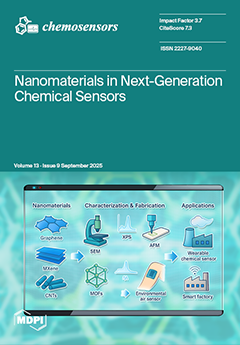Chemical sensors have undergone transformative advances in recent years, driven by the convergence of nanomaterials, advanced fabrication strategies, and state-of-the-art characterization methods. This review emphasizes recent developments, with particular attention to progress achieved over the past decade, and highlights the role of the
[...] Read more.
Chemical sensors have undergone transformative advances in recent years, driven by the convergence of nanomaterials, advanced fabrication strategies, and state-of-the-art characterization methods. This review emphasizes recent developments, with particular attention to progress achieved over the past decade, and highlights the role of the United States as a major driver of global innovation in the field. Nanomaterials such as graphene derivatives, MXenes, carbon nanotubes, metal–organic frameworks (MOFs), and hybrid composites have enabled unprecedented analytical performance. Representative studies report detection limits down to the parts-per-billion (ppb) and even parts-per-trillion (ppt) level, with linear ranges typically spanning 10–500 ppb for volatile organic compounds (VOCs) and 0.1–100 μM for biomolecules. Response and recovery times are often below 10–30 s, while reproducibility frequently exceeds 90% across multiple sensing cycles. Stability has been demonstrated in platforms capable of continuous operation for weeks to months without significant drift. In parallel, additive manufacturing, device miniaturization, and flexible electronics have facilitated the integration of sensors into wearable, stretchable, and implantable platforms, extending their applications in healthcare diagnostics, environmental monitoring, food safety, and industrial process control. Advanced characterization techniques, including in situ Raman spectroscopy, X-ray Photoelectron Spectroscopy (XPS, Atomic Force Microscopy (AFM), and high-resolution electron microscopy, have elucidated interfacial charge-transfer mechanisms, guiding rational material design and improved selectivity. Despite these achievements, challenges remain in terms of scalability, reproducibility of nanomaterial synthesis, long-term stability, and regulatory validation. Data privacy and cybersecurity also emerge as critical issues for IoT-integrated sensing networks. Looking forward, promising future directions include the integration of artificial intelligence and machine learning for real-time data interpretation, the development of biodegradable and eco-friendly materials, and the convergence of multidisciplinary approaches to ensure robust, sustainable, and socially responsible sensing platforms. Overall, nanomaterial-enabled chemical sensors are poised to become indispensable tools for advancing public health, environmental sustainability, and industrial innovation, offering a pathway toward intelligent and adaptive sensing systems.
Full article





